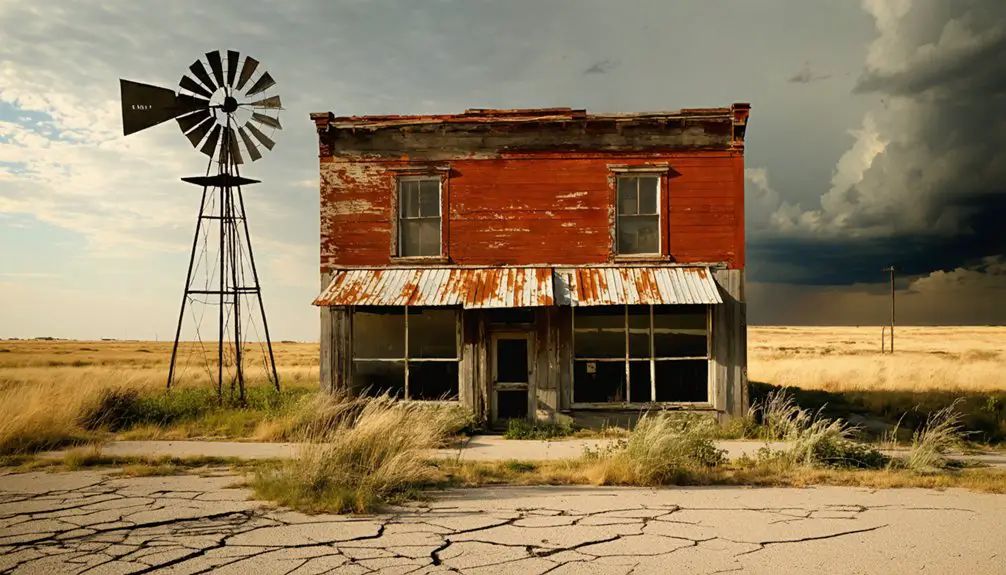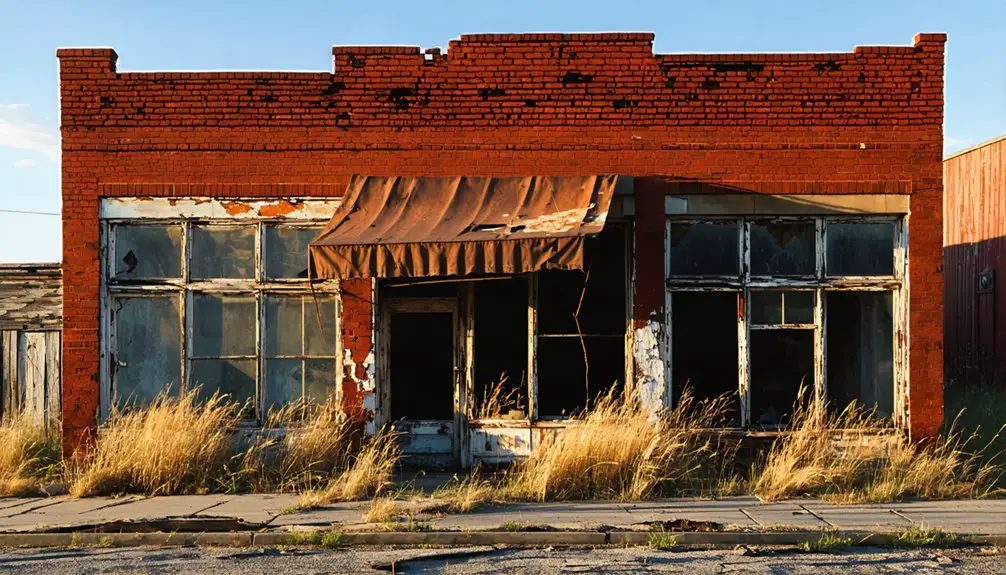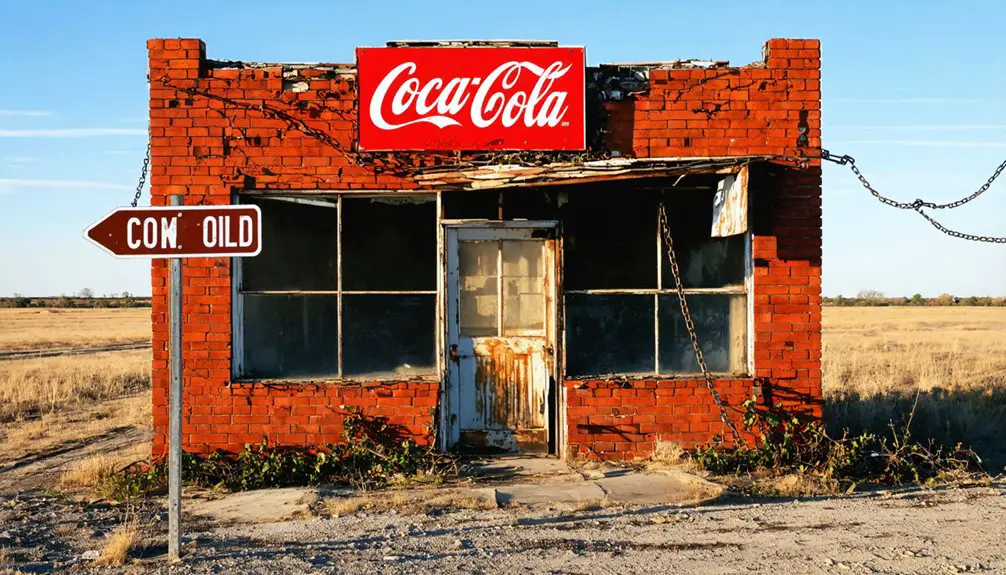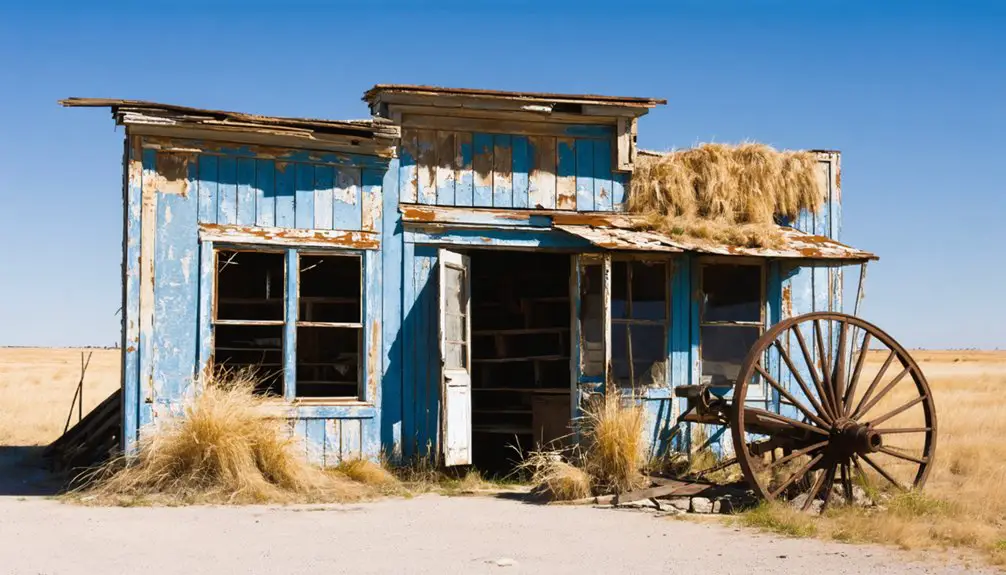You’ll find the ghost town of Dawson integrated into modern-day Tulsa, though it once thrived as an independent coal mining community with 6,000 residents at its 1913 peak. The town’s 2.5-square-mile footprint featured well-engineered streets, a stone jail, and extensive amenities before declining coal demand led to its 1949 annexation. Today, archaeological studies and the historic Dawson Cemetery offer glimpses into this fascinating chapter of Oklahoma’s industrial heritage.
Key Takeaways
- Dawson transformed from a thriving mining community of 6,000 residents to a ghost town following the decline of coal demand.
- The town featured extensive infrastructure including a hospital, theater, jail, and electric railroad system during its peak.
- Two devastating mining disasters in 1913 and 1923 marked significant turning points in the town’s history.
- By 1949, Dawson was annexed into Tulsa, marking the end of its existence as an independent mining community.
- Archaeological studies and the Dawson Cemetery, listed on the National Register of Historic Places, preserve the town’s mining heritage.
The Birth of a Mining Community
While the Dawson area began as a modest parcel within the Maxwell Land Grant, its transformation into a thriving mining community started when John Barkley Dawson purchased the land for $3,700 in the late 1860s. Like many topics with the name Dawson, this location required proper disambiguation to distinguish it from other places sharing the name.
You’ll find the origins of this mining legacy in the 1895 coal discovery, which caught the attention of C.B. Eddy, who bought the land for $400,000 in 1901. The Dawson Fuel Company quickly established operations, and when Phelps Dodge acquired the property in 1905, they transformed it into a powerhouse of coal production. The company developed ten connected mines that were linked by an innovative electric-powered railroad system.
The community’s resilience emerged as the company built extensive amenities, including housing, a hospital, and entertainment venues. By 1913, you’d have found yourself among 6,000 residents in a bustling town designed for both work and life.
Coal’s Golden Era in Dawson
You’ll find Dawson’s coal industry reached its peak around 1913 when the town’s population swelled to 6,000 residents, drawn by the promise of steady mining work under Phelps Dodge Corporation.
The workforce consisted largely of immigrant laborers who came from diverse European backgrounds, bringing their families to settle in the company-built homes that dotted the landscape. The area supported four major mines that provided employment opportunities for the growing population. The mining operations utilized both strip and shaft mining techniques to extract coal from the rich seams.
Despite the inherent dangers of mining, Phelps Dodge’s investment in quality housing and amenities like hospitals and theaters helped maintain a stable workforce throughout the peak production years.
Mining Workforce Demographics
During Dawson’s coal mining heyday, the workforce composition reflected the national mining industry’s demographics, with over 90% male workers dominating the labor force.
You’d have found strict gender roles in place, with women representing only a small percentage of mining personnel. The ethnic diversity primarily consisted of White workers, who made up about 89% of the workforce, while American Indian and Native Alaskan representation remained minimal. The mining operations required extensive protective services, with 200 security guards maintaining site safety.
Core positions included mining machine operators, first-line supervisors, and roof bolters, with supporting roles in engineering and technical fields. Workers typically logged 49-hour weeks in physically demanding conditions, with supervisory staff earning higher wages than laborers. Full-time employees earned an average of $87,971 annually, significantly outpacing other industries of the era.
The employment structure mirrored regional patterns seen in Oklahoma and neighboring states, focusing heavily on underground mining operations.
Coal Production Peak Years
Beyond the diverse workforce that powered Dawson’s mining operations, the town’s most prosperous period emerged in the early 1900s through the 1920s.
You’ll find that coal production reached its pinnacle in 1913, with an impressive 1.37 million tons extracted using modern mining techniques like shaft mining and electric rail systems.
Phelps Dodge’s 1905 acquisition transformed Dawson into a thriving community of 6,000 residents, complete with amenities including a hospital, theater, and golf course.
The coal was essential as it supplied coking fuel to copper-smelting operations throughout Arizona.
While this era marked unprecedented economic growth, it wasn’t without tragedy.
Two devastating Dawson disasters – the 1913 explosion that claimed 261 miners’ lives and another in 1923 – cast dark shadows over the town’s golden age of coal production, reminding us of the steep price paid for industrial progress.
Life in Early Dawson: Streets and Stories
If you’d walked Dawson’s streets in its early mining days, you’d have found a bustling coal town where Dawson Avenue served as the heart of daily commerce and community life.
Coal miners and their families lived in close-knit neighborhoods connected by roads that followed old Native American paths, some dating back to an 1835 Osage hunting trail established by Capt. J.L. Dawson.
The town’s 2.5 square miles contained the essential elements of community life – from the stone-built jail enforcing strict speed limits to the local auto shop owned by future Tulsa City Councilor Mr. Patrick. Residents enjoyed entertainment at the local theater where children would gather on Saturdays to watch serials. Today, while the original town has faded into history, Dawson Avenue remains as a lasting reminder of this once-thriving community.
Daily Coal Town Life
Life in Dawson flourished with modern amenities that were rare for early 1900s mining towns. You’d find a bustling community of 9,000 residents enjoying the state’s largest opera house, where social gatherings centered around billiards, dancing, and bowling.
The company-built homes connected to mines via electric railways, offering comfort unusual for the era. Your daily routine might include shopping at the department store, catching a movie at the theater, or watching local sports teams compete.
If you were a miner’s child, you’d attend the state’s only accredited coal-town school, taking diverse classes from auto mechanics to biology. Community events thrived at two churches, the swimming pool, and the golf course.
Despite the remote location and mining dangers, Phelps Dodge Corporation guaranteed you’d have access to modern healthcare at the local hospital.
Streets Through Mining Years
While Dawson Road traced its origins to an ancient Osage hunting trail, the town’s street system evolved into a carefully engineered network supporting its thriving coal economy.
You’d find the streets strategically laid out across 2.5 square miles, connecting residential areas to essential mining operations and railway links. The town’s mining infrastructure shaped every aspect of street planning, from the placement of repair shops to the careful engineering required to prevent road collapse over underground mine shafts.
As you walked these streets in the 1920s, you’d discover a bustling community where Mr. Patrick’s repair shop, local stores, and schools created vibrant neighborhood hubs. With mines reaching depths of 100 feet underground, engineers had to carefully plan and reinforce street foundations.
The street maintenance crews worked diligently to keep roads stable despite the extensive mining beneath, ensuring safe passage for both industry and residents.
The Historic Dawson Jail
Since its construction in August 1924, the Dawson Jail served as a cornerstone of law enforcement in this independent Oklahoma town before its annexation into Tulsa. The jail’s architecture featured thick stone-concrete walls, emphasizing durability and security for holding local lawbreakers.
Built in 1924, Dawson’s stone-walled jail stood as a symbol of authority in this once-independent Oklahoma community.
You’ll find that local law enforcement initially targeted speeding motorists who exceeded 15 mph, sparking tension between officials and business owners who worried these strict measures might deter visitors.
While most offenders faced fines rather than imprisonment, the jail symbolized Dawson’s commitment to maintaining order during its small-town era.
Today, you can still spot the abandoned structure within Tulsa’s city limits, though it’s fallen into disuse since the late 1940s – a ghostly reminder of Dawson’s independent past.
Landmarks and Local Heritage

The haunting Dawson Cemetery stands as the town’s last significant landmark, earning its place on the National Register of Historic Places through its connection to two devastating mining disasters.
You’ll find white iron crosses emerging from the overgrown landscape at the base of scenic buttes, their cemetery symbolism a stark reminder of the town’s tragic past. A weathered notebook inside an old mailbox invites you to join countless others who’ve explored this historic site, where ghostly encounters are frequently reported.
- Mysterious bobbing lights resembling miners’ headlamps appear after dark
- Full-bodied apparitions approach visitors before vanishing into thin air
- Unexplained voices, laughter, and moans echo through the grounds
- Orbs and spectral figures roam both cemetery and surrounding ghost town
- The desert’s natural sounds amplify the site’s eerie atmosphere
Economic Rise and Decline
Beyond the somber cemetery grounds lies a story of dramatic economic evolution that shaped Dawson’s destiny.
A tale of transformation lies beyond these silent graves, where economic tides forever altered a community’s path.
You’ll find a town that once pulsed with the energy of 3,500 residents, driven by coal mining operations that fueled the region’s growth since the late 1800s.
The community’s economic changes tell a tale of both prosperity and decline. When coal drove the economy, you’d have seen a bustling 2.5-square-mile town with schools, stores, and a post office established in 1895.
The community’s resilience showed in its 1923 incorporation and construction of municipal buildings.
But by 1949, declining coal demand forced Dawson’s annexation into Tulsa. What was once a self-sufficient mining town evolved into a quiet neighborhood within Tulsa‘s expanding borders, marking the end of its independent economic era.
From Independence to Annexation

While Dawson thrived as an independent mining community in early 20th century Oklahoma, you’d find evidence of its autonomy in the 1924 stone-concrete jail and strict local ordinances.
The town’s independent governance reflected a spirit of self-determination, with local businessmen actively engaging in policy debates and the Justice of the Peace maintaining community-focused law enforcement.
As mining operations declined and Tulsa expanded, you’ll see how Dawson’s path led to inevitable annexation.
- European and Mexican immigrants contributed to the town’s unique demographic makeup
- Local speed limits of 15 mph showcased the town’s authority to self-govern
- Fines were preferred over jail time to maintain the town’s appeal
- Civic engagement shaped policies affecting business and social climate
- Mining disasters and economic decline hastened the shift to Tulsa control
Preserved Memories and Artifacts
Throughout decades of archaeological study, you’ll find Dawson’s rich history preserved through an impressive collection of artifacts and structures that paint a vivid picture of this once-bustling mining community.
You can trace daily life through excavated foundations, brick hearths, and recovered items like projectile points and pottery spanning from the Archaic to Mississippian periods.
Community memory lives on in over thirty relocated buildings, including the iconic four-room houses with central chimneys that now stand in neighboring towns.
You’ll discover artifact preservation efforts at local museums, particularly the Ratón Museum’s collection of 800 photographs.
The Dawson Cemetery, with its white iron crosses marking mining disaster victims, serves as both a memorial and authentic historical landscape that continues to draw visitors today.
Modern-Day Traces and Tourism

Today’s visitors to Dawson find themselves traversing a carefully controlled experience of this historic ghost town.
While many tourists confuse this site with Oklahoma’s Dawson (now part of Tulsa), New Mexico’s Dawson operates as a private ranch that opens its gates only during specific times.
You’ll find ghost tours highlighting the town’s haunted history, and cemetery memorials drawing visitors on Memorial Day to honor their buried relatives.
- Access limited to biennial reunions on Labor Day weekends in even-numbered years
- Special permission required from Colfax Land & Cattle Company for site visits
- Ghost tours available through Albuquerque Ghosts and US Ghost Adventures
- Cemetery listed on National Register of Historic Places remains accessible
- Photography opportunities of remaining foundations, ruins, and historic gravesites
Frequently Asked Questions
What Happened to the Families Who Lived in Dawson After Annexation?
Like a GPS rerouting lives, you’d find family relocation scattered most families across Tulsa after 1949. When essential services closed, your community impact meant choosing between staying in changed neighborhoods or seeking opportunities elsewhere.
Are There Any Mining Accidents or Disasters Recorded in Dawson’s History?
You won’t find specific mining accident reports for Dawson, Oklahoma in historical records. While nearby Oklahoma towns experienced mining disasters, there’s no verified safety incidents within Dawson’s own mining operations.
What Native American Tribes Originally Inhabited the Dawson Area?
Moving with the seasons, claiming the plains, you’d have found the Wichita confederacy and Plains tribes like the Comanche in this region, shaping its early tribal history and cultural significance.
Did Dawson Have Any Notable Sports Teams or Recreational Activities?
While you’d likely have found sports and recreation in Dawson’s schools and mining community, there aren’t any documented notable teams. Hunting, community picnics, and motor-related activities were common recreational pursuits.
Were There Any Churches or Religious Organizations Established in Dawson?
Truth is stranger than fiction, but you won’t find documented church history in the records. There’s no concrete evidence of established religious organizations or formal churches in Dawson’s timeline.
References
- https://usghostadventures.com/haunted-places/dawson-ghost-town-and-cemetery/
- https://abandonedok.com/dawson-jail/
- https://en.wikipedia.org/wiki/Dawson
- https://www.youtube.com/watch?v=tkRD0xqeEvc
- https://www.ghosttowns.com/states/ok/dawson.html
- https://npgallery.nps.gov/GetAsset/ea7cd9b3-70a7-49e5-8196-bdd8efc03f7a
- https://tulsapreservationcommission.org/resources/tulsa-history/industry/
- http://historictulsa.blogspot.com/2009/10/dawson-school-1908.html
- https://theperrynews.com/dawson-dallas-township-grew-by-railroading-mining/
- https://www.okhistory.org/publications/enc/entry?entry=CO001



